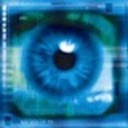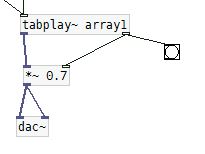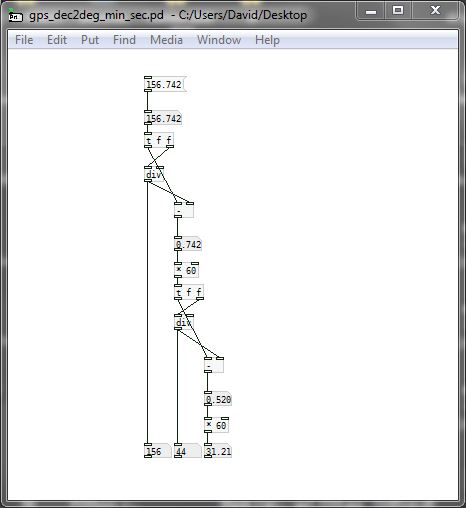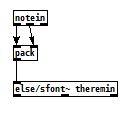-
 whale-av
posted in technical issues • read more
whale-av
posted in technical issues • read more@donnerbono https://forum.pdpatchrepo.info/topic/14477/toggling-visibility-of-sliders-buttons-in-pd
It is best to use the coords message, as the donecanvasdialog message does not work well since Pd 0.49.... as seen in the example it retains the first view the first time that the second view is selected.
It changes the area of a sub-patch displayed through a GOP window.You could also use abstractions for each window and make them visible by sending them [vis 1( messages.
example.zip
Open all three files and then click the messages in each as desired.......
You might want to add a message to turn off DSP processing in each hidden patch as you switch.Of course it could also be done with dynamic patching
David. -
 whale-av
posted in technical issues • read more
whale-av
posted in technical issues • read more@willblackhurst For the DAC the numbers have to be pushed out at the sample rate to create the analogue audio wave.... or it is just a meaningless data dump. And there is no "jamming".... it is just that the data then moves through the audio stream in Pd at that rate.
When a wav file is copied on the computer the data is of course moved as fast as the storage medium and the processor and the RAM I/O can manage..... which is also the case when you load audio to an [array].
[snapshot~] does what it should... outputs the audio stream value at the time that it is banged...... but because control rate operations are sent between blocks it reports the last value from the previous block.
So it does use the array list data if the array is being streamed (played) but only reports that one value at the point to which it is attached in your patch and at the time that it is banged.
And if you sample the stream from [tabplay~] after a [* 0.5] then the value will be halved.
If you want to see the whole previous block then use [print~] but that only reports the values to the console so it is not useful except for analysis when understanding how you want to use [vsomething~] objects.How Pd works... is in your Pd folder....... \doc\1.manual\resources\chapter2 ..... part 2.5.2 for tilde objects (audio processing)...
David. -
 whale-av
posted in technical issues • read more
whale-av
posted in technical issues • read more@Shabroy Only a wild guess...... that it might have something to do with the sample rate of the audio file?
Android native is 48kHz. It can resample but maybe PdParty has no instruction set for that?
David. -
 whale-av
posted in technical issues • read more
whale-av
posted in technical issues • read more@willblackhurst It's all numbers in a computer... digital.
As simply as possible.........
Tilde objects set processing of the digital audio thread in Pd. The digital audio is a stream of numbers representing the height of the equivalent analogue signal wave..
These numbers only become a voltage..... an analogue waveform when they are passed to the DAC... the digital to analogue converter.... your soundcard output.
The ADC is where the analogue signal is converted to numbers for input to the digital audio thread.
Audio files are stored on the computer disk as numbers.....
The numbers are read, streamed, processed and output at the sample rate.
The not simple answer can be found searching for FFT.
David. -
 whale-av
posted in technical issues • read more
whale-av
posted in technical issues • read more@Hello_Hello Welcome to the forum..
Please upload your patch. It is not normal.... so we need to see why it might be happening.
When you start a post you will see an UP arrow above where you are typing...... click that and browse to your patch to upload it.
David. -
 whale-av
posted in technical issues • read more
whale-av
posted in technical issues • read more@Shabroy Looks like you should be getting playback.
Are the arrays filled? ....... maybe you should put a [loadbang] to the read messages to fill the arrays at startup.
Is audio turned on?
You can do this if [loadbang] works in PdParty....... like_this.pd
David. -
 whale-av
posted in technical issues • read more
whale-av
posted in technical issues • read more@Shabroy I have modified conversion from decimal in the post above, adding the triggers.
You get the error message because when [tabplay~] gets to the end of the track it is sending a bang into the right inlet of [*~ 0.7]
So just remove that cord I think.....
David

-
-
 whale-av
posted in technical issues • read more
whale-av
posted in technical issues • read more@jameslo Yes..... drunk and way past bedtime so rightly chastised.
Don't let me be misunderstood....
My intentions were good.
David -
 whale-av
posted in technical issues • read more
whale-av
posted in technical issues • read more@Shabroy https://www.calculatorsoup.com/calculators/conversions/convert-decimal-degrees-to-degrees-minutes-seconds.php
So........ (triggers included) gps_dec2deg_min_sec.pd
David.

